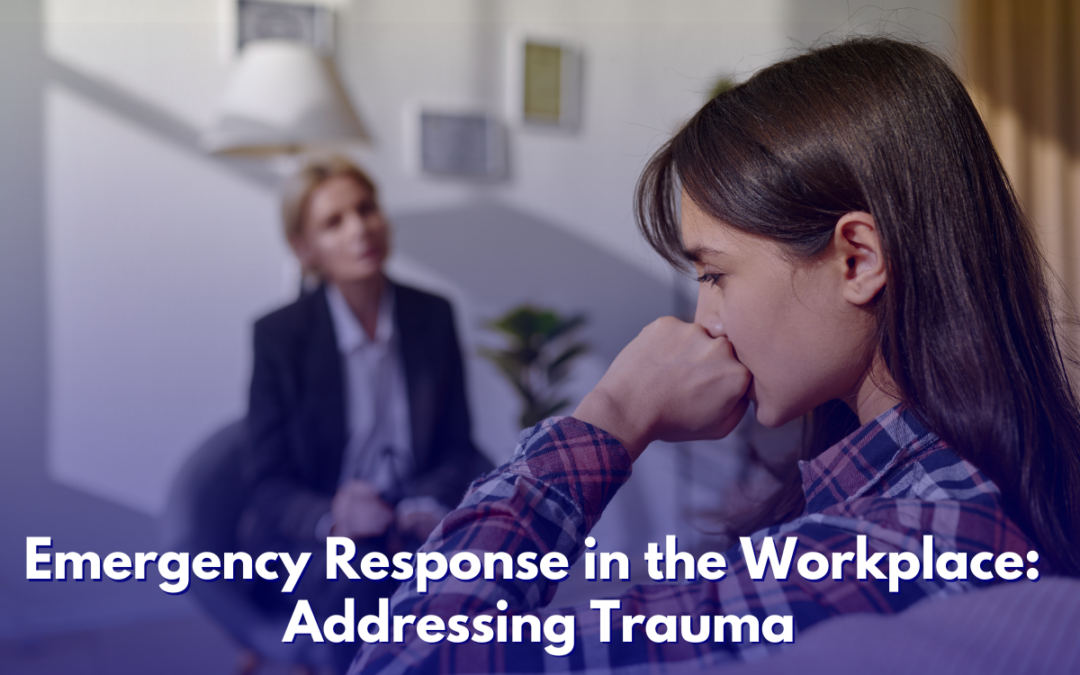There seem to be traumatic, life-altering events happening all around us every other day. Everyday in the news, there’s a new tragedy… and there are even more events that don’t get national attention.
This daily stress is weighing on workers, mourning tragedies across the country and worrying a tragedy might strike their workplace next. Not only does this impact the productivity of a workplace, but it also leads to increasingly negative mental health impacts on the people you work with. It’s a heavy burden for anyone to go through alone.
Fortunately, companies can help their employees by being trained to provide quick and sensitive responses when employees face such life-altering events.
Trauma-Informed
What does it mean to be a trauma-informed workplace? It’s all about recognizing how trauma impacts people and having the tools to support people going through it.
Trauma can lead to stress, anxiety, loss of confidence, and an inability to act or think clearly under pressure; these feelings lead to behavioral changes like increased irritability, jumpiness, and standoffishness.
In response to this need, dozens of training programs have cropped up to help managers and business leaders address trauma in the workplace. It’s all about teaching leaders to recognize the signs of emotional distress in employees so they can connect them with the proper services to support them.
Work Appropriate Support
It’s not as simple as supporting a friend through a crisis (not that this would be a straightforward task in and of itself). The work environment makes an already-difficult situation even more complicated because you have to use professional channels to make a human connection.
Kelsey Crowe, Owner of Empathy Bootcamp in San Francisco, trains leaders in what she calls an “empathy menu” of things to say and do, as well as minefields to avoid. It can be difficult to know what to say or how to reach out, but Kelsey Crowe urges even colleagues who don’t know someone well to reach out if they have useful guidance to share, especially from a similar experience a coworker could be going through. Those who are close to a coworker should go the extra mile of support beyond just saying “I’m sorry.”
Kind words, sincere gestures, and shared insights are great ways to show someone you care. To be sure you aren’t putting your colleague in an uncomfortable position, however, these opportunities for connection should not happen in the middle of meetings or in a way to put someone on the spot. This can help the person feel more at ease and will make your bid for connection feel genuine, rather than a professional courtesy.
Options from Kelsey Crowe’s empathy menu… a coffee or doughnut left on a coworkers desk after a difficult day, offering to take someone out to lunch during your break, pooling vacation time to donate to a colleague in need, offering to pick up work slack for someone distracted by trauma, or organizing a fundraiser for a colleague’s favorite charity. Listen when someone tells you what they need and make them feel supported, even with a small gesture.
It Pays to Plan
Whatever the traumatic event is, it pays to have an action plan in place for when tragedy strikes your own workplace, which can include bringing in EAP resources and local government mental health professionals to develop a long-term agenda to deal with the aftermath. Immediate needs can include sharing a list of providers who are taking new patients and arranging group discussions facilitated by a mental health professional.
It’s crucial to remember not all team members will want help immediately; some will need more time before they’re ready to seek mental health treatment. Not everybody responds to trauma the same way—that doesn’t mean one person’s trauma is more real or more severe than another.
Make Aware
Regularly remind employees what benefits they already have access to; a stressful time is made even more taxing when someone is trying to figure out how to ask for help, assuming they know they even need help.
Employee benefits can be a life saver for coworkers dealing with an illness, a loss in their personal life, or other trauma. Make it very clear what resources are available to them, in plain language, so as to not add to someone’s plate.
Make sure your HR leaders are well-versed in your offerings so they can appropriately guide and support employees in need.
Support and Connection
At the end of the day, it’s all about remembering we’re not just workers—we’re human beings. We aren’t just machines executing tasks all day; we’re impacted by the events around us. And a kind word can be life changing.
Addressing trauma within your organization shows employees that you care about them as people; strengthening the ties between colleagues can be a boon for workers, and it creates a positive work environment during a turbulent time.
This blog was taken from SHRM on March 15, 2023.
